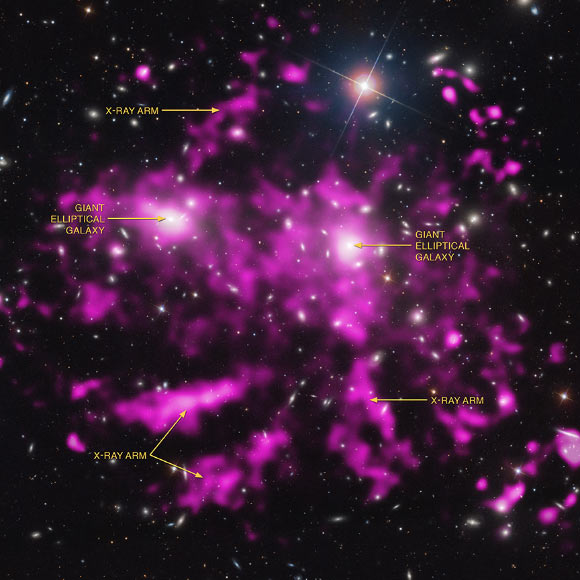Astronomers using NASA’s Chandra space observatory have discovered enormous arms of X-ray emitting plasma in the Coma cluster of galaxies.

This composite image shows enormous arms of plasma in the Coma galaxy cluster. Image credit: X-ray – NASA / CXC / MPE / J. Sanders et al.; optical – SDSS.
Coma is an unusual galaxy cluster because it contains not one, but two giant elliptical galaxies near its center. These galaxies are probably the vestiges from each of the two largest clusters that merged with Coma in the past.
The newly discovered arms span at least half a million light years. Their discovery provides insight into how the Coma cluster has grown through mergers of smaller groups and clusters of galaxies to become one of the largest structures in the Universe held together by gravity.
The scientists say that these arms were most likely formed when smaller galaxy clusters had their gas stripped away by the head wind created by the motion of the cluster through the hot gas, in much the same way that the headwind created by a roller coaster blows the hats off riders.
From their length, and the speed of sound in the hot gas, the arms are estimated to be about 300 million years old, and they appear to have a rather smooth shape. This gives the researchers some clues about the conditions of the hot gas in Coma.
Most theoretical models expect that mergers between clusters like those in Coma will produce strong turbulence, like ocean water that has been churned by many passing ships. Instead, the smooth shape of these lengthy arms points to a rather calm setting for the hot gas in the Coma cluster, even after many mergers.
Large-scale magnetic fields are likely responsible for the small amount of turbulence that is present in Coma. Estimating the amount of turbulence in a galaxy cluster has been a challenging problem for astrophysicists. The team has found a range of answers, some of them conflicting, and so observations of other clusters are needed.
Two of the arms appear to be connected to a group of galaxies located about two million light years from the center of Coma. One or both of these arms connects to a larger structure and spans a distance or at least 1.5 million light years. A very thin tail also appears behind one of the galaxies in Coma.
The findings appear online in the journal Science (arXiv.org version).
______
Bibliographic information: J. S. Sanders et al. 2013. Linear Structures in the Core of the Coma Cluster of Galaxies. Science, vol. 341, no. 6152, pp. 1365-1368; doi: 10.1126/science.1238334







